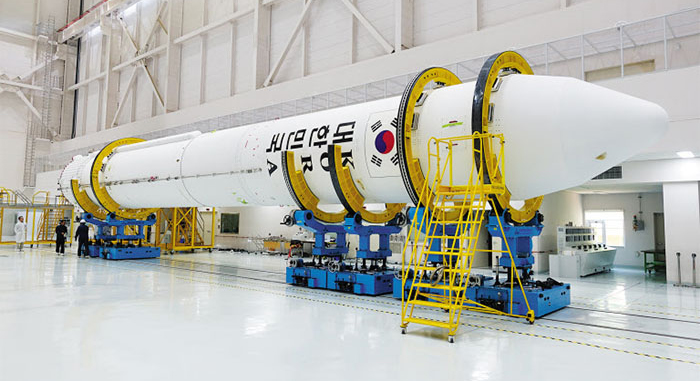Featured image: KARI
Launch Window | June 21, 2022 – 08:00 UTC | 17:00 KST |
|---|---|
Mission Name | Nuri Test Flight 2 |
Launch Provider | Korea Aerospace Research Institute |
Customer | Korea Aerospace Research Institute |
Rocket | Nuri (KSLV-II) |
Launch Location | LC-2, Naro Space Center, Goheung, South Jeolla Province, South Korea |
Payload mass | Up to 1,500 kg (3,300 lb) |
Where is the spacecraft going? | Sun-synchronous orbit (SSO) |
Will they be attempting to recover the first stage? | No, Nuri is not capable of recovery |
Where will the first stage land? | In the sea between South Korea and Japan |
Will they be attempting to recover the fairings? | No, Nuri is not capable of recovery |
Are these fairings new? | Yes |
How’s the weather looking? | TBD |
This will be the: | – 2nd mission of the Nuri rocket – 5th Korea Aerospace Research Institute mission – 1st Korea Aerospace Research Institute mission of 2022 – 5th mission of a KSLV rocket – 65th orbital launch attempt of 2022 |
Where to watch | Livestream |
What Does All This Mean?
Korea Aerospace Research Institute (KARI) is preparing for the second test flight of their Nuri rocket, which will be launched from the Naro Space Center, in South Korea. If this launch is successful, South Korea will become the seventh country to successfully launch a fully indigenous rocket.
The rocket was expected to launch on June 16, however it was postponed due to an abnormality with a sensor in the first stage LOX tank. The rocket is now expected to launch on June 21.

Nuri Flight Test 2
Nuri (누리), which means “world” in Korean, (also known as KSLV-II) is South Korea’s second rocket. It is the successor of the Naro-1 (KSLV-I), South Korea’s first ever rocket, which was successfully launched in 2013. Because the first stage of Naro-1 was built in Russia, Nuri will be the countries first fully indigenous rocket. The rocket was primarily developed by KARI, but around 300 companies also played a role in the development, including Korea Aerospace Industries, Hanwha Aerospace, and Hyundai Heavy Industries.
Test Flight 2 is the second attempt to successfully launch the Nuri rocket after a failed first mission in October 2021. During the first test flight, the rocket successfully flew its the planned altitude of 700 km but the engine burned out 46 seconds early, resulting in the dummy satellite failing to reach its intended orbit.
After investigating the failure, KARI found that the device that anchored the helium tank in the rockets third stage was not fixed securely. KARI has since worked to improve the rocket by strengthening this device. This will hopefully allow Nuri to fly stably during the most dynamic stages of flight.
On this flight, Nuri will carry a dummy satellite, a performance verification satellite, and 4 cube satellites to orbit. Once operational, it is hoped that Nuri will be used to launch Earth observing satellites, such as KARI’s KOMPSAT which has previously been launched on the Ariane 5 rocket. KARI has also planned to use Nuri for South Korea’s future Moon exploration missions, with an improved version of the rocket expected to launch a lunar lander in 2030.

2018 Test Flight
A single stage test version of the rocket was launched on November 28, 2018 from Naro Space Centre, allowing KARI to verify the performance of their engine and flight control systems. During the test, the main engine burned for 151 seconds, surpassing the initial goal of 140 seconds. The rocket then reached a maximum altitude of 209 km after flying for 319 seconds. The rocket landed in international waters between Korea’s Jeju Island and Japan’s Okinawa Island.
What Is Nuri?
Nuri is a three stage rocket, capable of launching a 1500 kg payload into a 600–800 km low-Earth orbit (LEO) and a 2,600 kg payload into a 300 km LEO. The rocket is 47.2 m (155 ft) in height, and 3.5 m (11 ft) in diameter.
First Stage
The rocket’s first stage uses four KRE-075 sea level engines, which together produce 2,612 kN of thrust with a specific impulse (ISP) of 289.1 seconds. The stage burns for 127 seconds and uses Jet A-1 and Liquid Oxygen (LOx) propellant.
Second Stage
The second stage uses a single KRE-075 Vacuum engine, which has a wider nozzle than the Sea Level engine for increased efficiency and performance in a vacuum environment. The stage will burn for 148 seconds, and like the first stage engines, this stage uses Jet A-1 and LOX fuel. The engine produces 788 kN of thrust and has a ISP of 315.4 seconds in vacuum.
Third Stage
The rockets third stage uses one KRE-007 engine which produces 69 kN of thrust. The engine will burn for 498 seconds, and just like the first and second stages it uses Jet A-1 and LOX fuel. The third stage has an ISP of 325.1 seconds in vacuum.

Flight Profile*
| HR/MIN/SEC | EVENT | ALTITUDE |
| 00:02:07 | First stage separation | 59 km |
| 00:03:53 | Fairing jettison | – |
| 00:04:34 | Second stage separation | 258 km |
| 00:16:16 | Dummy satellite released | 700 km |
Future Versions Of Nuri
An upgraded version of Nuri, the GEO KSLV, is currently in development, which will be capable of taking payloads to geostationary orbit. This version will use four KRE-090 engines on the first stage, assisted by four side boosters each with a single KRE-090 engine. The second stage will use a single vacuum optimized version of the KRE-090 engine. The third stage will use a KRE-010V oxidizer-rich staged combustion engine.






That future version sounds more like a whole new rocket than a version of the one in this test.